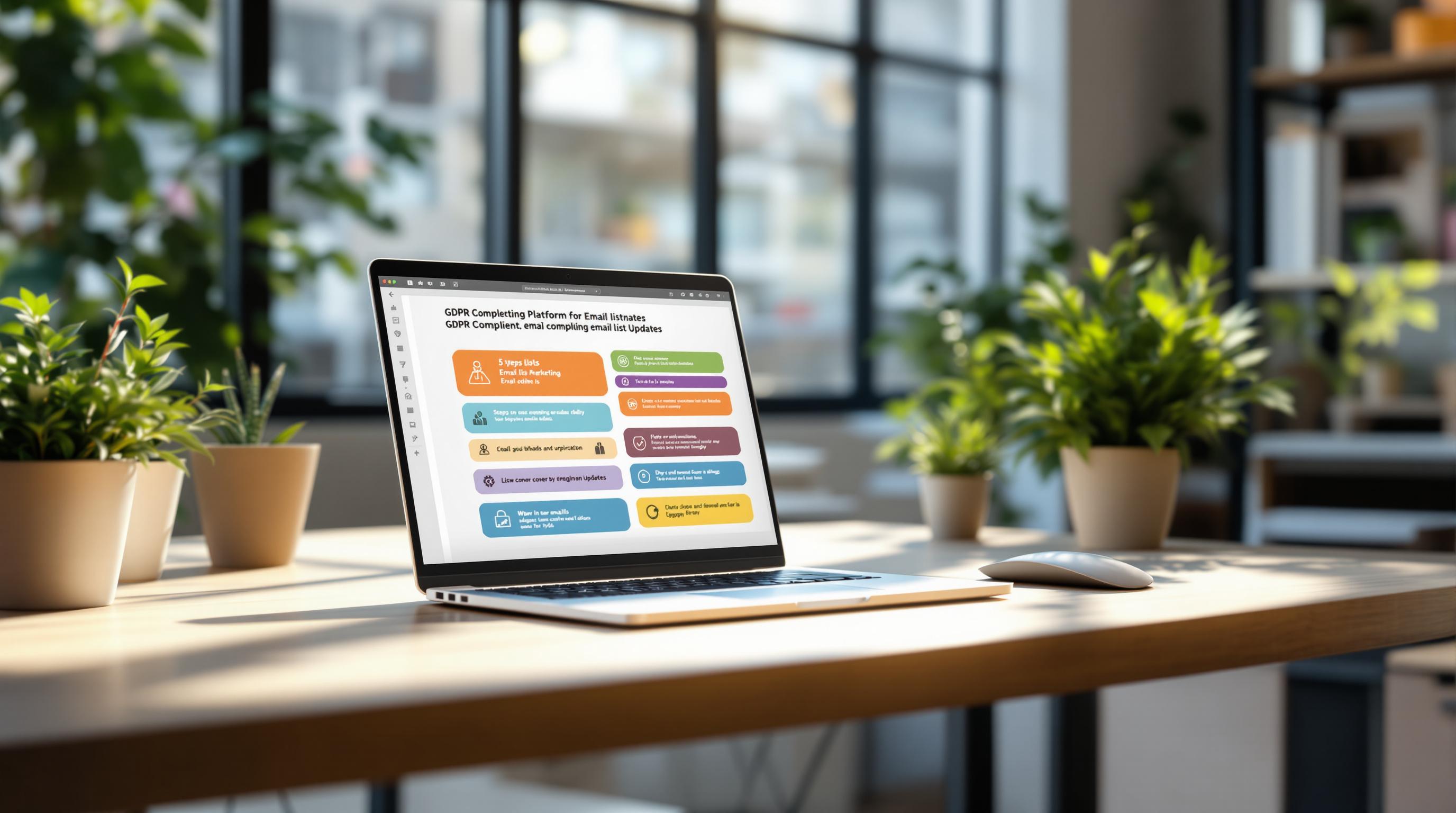Want to stay GDPR-compliant with your email marketing? Here’s what you need to know:
- Consent must be clear, specific, and freely given: No pre-checked boxes or vague agreements. Users must actively opt in.
- Double opt-in is recommended: A two-step process ensures users confirm their consent, with timestamps and records for proof.
- Keep detailed records: Log when, how, and why consent was obtained, and ensure easy withdrawal options like visible unsubscribe links.
- Non-compliance is costly: Fines can reach up to €20 million or 4% of global turnover.
Start by simplifying your consent process, using tools that automate record-keeping and ensure transparency. Let’s dive into how to get it right.
GDPR Email Consent Principles
GDPR outlines strict rules for email consent, focusing on user privacy, control, and transparency in how data is handled.
What Counts as GDPR-Compliant Consent?
Under GDPR, consent must be freely given, specific, informed, and unambiguous [1][2]. In simple terms, users need to actively agree to share their data through clear, intentional actions.
Here’s an example of a compliant request:
"Check this box to receive our newsletter."
Now, compare that to a non-compliant example:
"Using our website means you agree to receive marketing emails."
To meet GDPR requirements, businesses should:
- Use Active Opt-ins: Ensure checkboxes are not pre-checked and include clear consent language.
- Provide Clear Actions: Keep subscription options separate from terms of service.
- Separate Choices: Let users pick what they want to receive - newsletters, promotions, or updates - using individual checkboxes.
Consent and Its Purpose
Every data processing activity must have its own documented consent [3]. This means businesses are responsible for:
- Clearly explaining the purpose of data collection upfront.
- Keeping detailed records of why and how consent was obtained.
- Asking for fresh consent if the data will be used in new ways.
- Maintaining proper documentation for each specific purpose.
Non-compliance can result in hefty penalties - up to €20 million or 4% of annual global turnover, whichever is higher [2].
To stay on track, businesses should implement clear processes for collecting and managing consent. Using reliable tools and systems can help ensure GDPR rules are consistently followed.
Collecting and Managing Consent: Best Practices
Effective consent management not only keeps you compliant but also builds trust and openness with your audience.
Double Opt-In for Clear Consent
Double opt-in is a two-step process that ensures users intentionally give their consent. It’s widely recognized as a reliable method for meeting GDPR requirements. Here’s how it works: after someone signs up, they receive a confirmation email to verify their subscription by clicking a link.
To meet GDPR standards, a double opt-in process should include:
- A clear consent form that explains how data will be used
- A verification email outlining specific consent details
- A confirmation link that logs the user’s action, along with a timestamp and IP address
- Documentation of both steps to ensure compliance
"The user has an absolute right to object to direct marketing." - Article 21 of the GDPR [3]
Keeping Detailed Consent Records
Under GDPR, maintaining detailed consent records is non-negotiable. These records should include:
| Consent Element | Information to Capture |
|---|---|
| Timestamp | Date and time of both initial consent and verification |
| Method | How consent was obtained (e.g., form, checkbox) |
| Context | The exact wording or language shown during consent |
| Verification | Evidence of double opt-in completion |
| Purpose | The specific reason for collecting the data |
| Source | Where and how the user provided their consent |
Simplifying Opt-Out Options
Making it easy for users to withdraw their consent is just as important as obtaining it. Every marketing email should provide:
- A clear and visible unsubscribe option
- Immediate processing of opt-out requests without fees or complications
- Records of withdrawn consent
- A confirmation message to users once their request is processed
Regular audits of your consent records and processes are essential to staying compliant. To save time and avoid manual errors, consider using automation tools designed for managing consent efficiently.
sbb-itb-8abf799
Tools for GDPR Compliance
Managing GDPR-compliant email lists requires tools that can effectively handle consent collection, documentation, and user rights. Automation tools make this process easier by simplifying consent management and record-keeping.
Email Extractor Tool - AI-Powered Email Collection

The Email Extractor Tool uses AI to support GDPR-compliant lead generation. This Chrome extension offers features designed to meet GDPR standards:
| Feature | GDPR Compliance Advantage |
|---|---|
| Automated Detection | Minimizes errors during email collection |
| CSV/TXT Export | Keeps consent records well-organized |
| Easy Cancellation | Facilitates user rights to withdraw consent |
| Scalable Plans | Adjusts to different business needs |
This tool is suitable for businesses of all sizes, offering flexible options for handling varying email volumes.
Automation in Consent Management
Automation tools go beyond manual processes, addressing GDPR requirements with greater efficiency and accuracy. Modern consent management solutions provide businesses with:
| Automation Feature | Impact on Business |
|---|---|
| Consent Recording & Documentation | Automatically logs consent details and generates compliance records |
| Data Rights Management | Simplifies handling of access and deletion requests |
| Opt-out Processing | Ensures swift action on withdrawal requests |
"GDPR mandates explicit, informed, and unambiguous consent for all email communications" [1][2][4]
When using automation tools for GDPR compliance, businesses should prioritize:
- Transparency: Clearly documenting and explaining all automated processes
- User Rights: Providing easy access to consent and data management
- Record Keeping: Automatically saving consent evidence and interaction logs
- Regular Audits: Automating compliance checks to ensure continued adherence to GDPR regulations
Conclusion and Key Actions
Staying compliant with GDPR in email marketing requires careful consent management and the right tools. Here’s a quick look at the main focus areas for achieving compliance:
| Compliance Area | Key Actions | Steps to Implement |
|---|---|---|
| Consent Collection | Obtain clear opt-ins | Use double opt-in forms, include clear language about consent, and state the specific purpose of data collection |
| Documentation | Keep detailed records | Log timestamps, methods, and the content of consent forms |
| User Rights | Offer user-friendly controls | Provide easy opt-out options, access to data, and clear processes for withdrawing consent |
| Tool Integration | Choose GDPR-compliant tools | Implement automation tools that help track and manage consent effectively |
For instance, tools like the Email Extractor Tool can simplify GDPR compliance by automating email collection and ensuring proper record-keeping.
Key Recommendations:
- Regularly review your consent collection practices to ensure they meet GDPR standards.
- Train your team to understand GDPR rules and the importance of managing consent properly.
- Keep thorough records of all consent-related activities to avoid compliance issues.
- Update privacy notices regularly and communicate clearly with users about their rights and any requests they make.
The key to success lies in consistently applying these practices while fostering transparency in your email marketing efforts.



